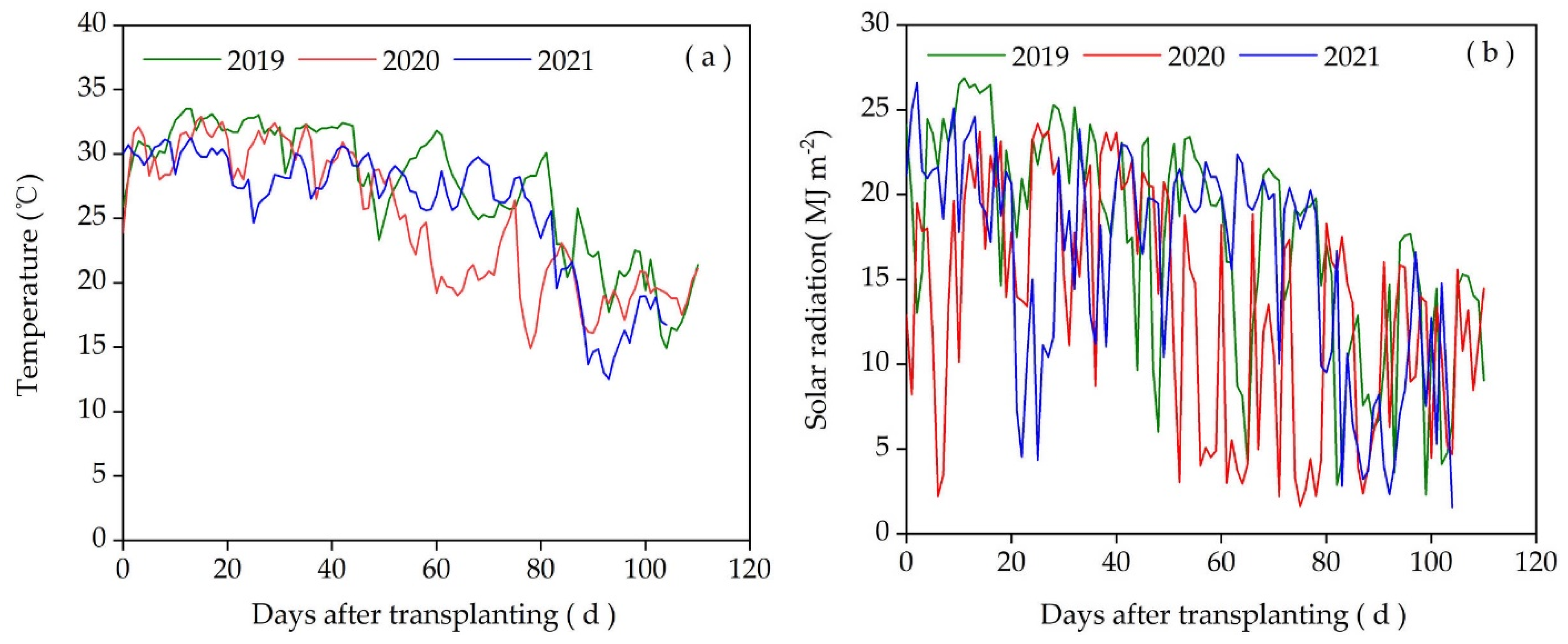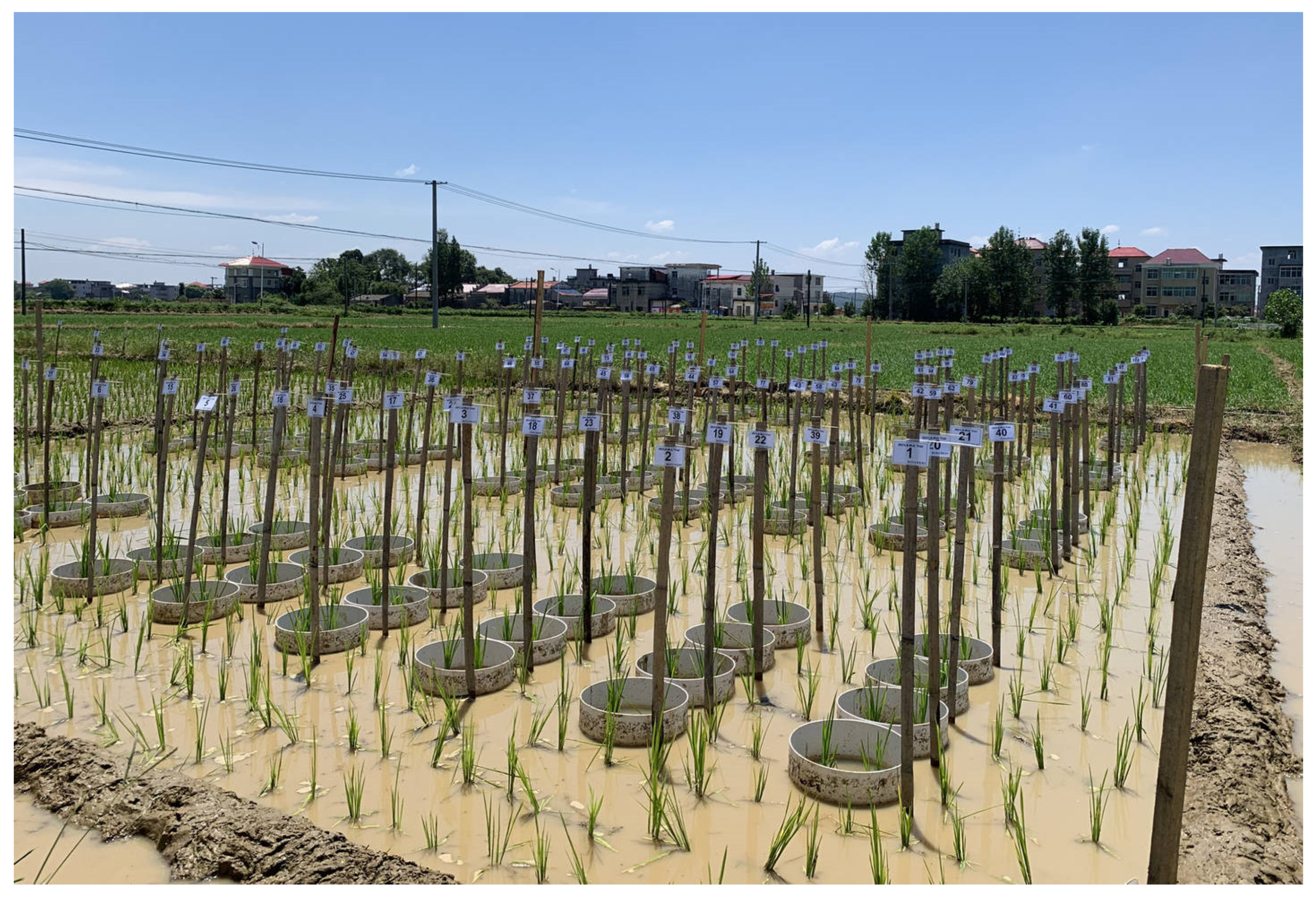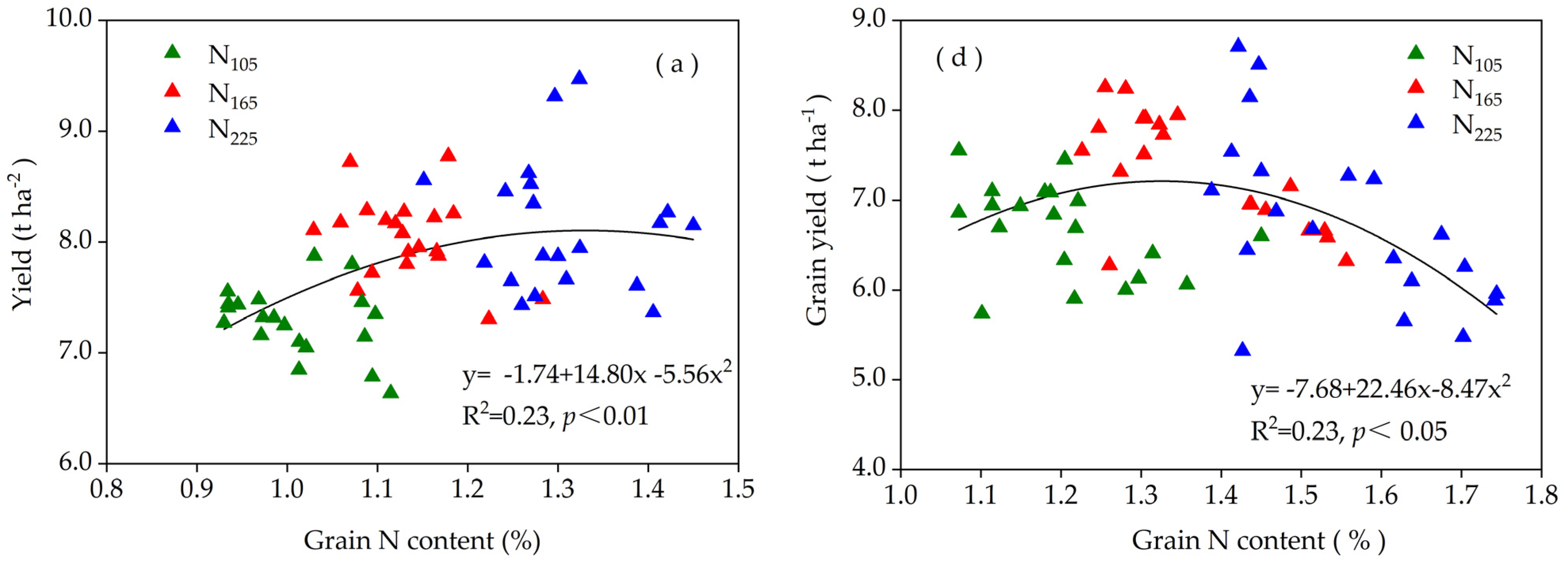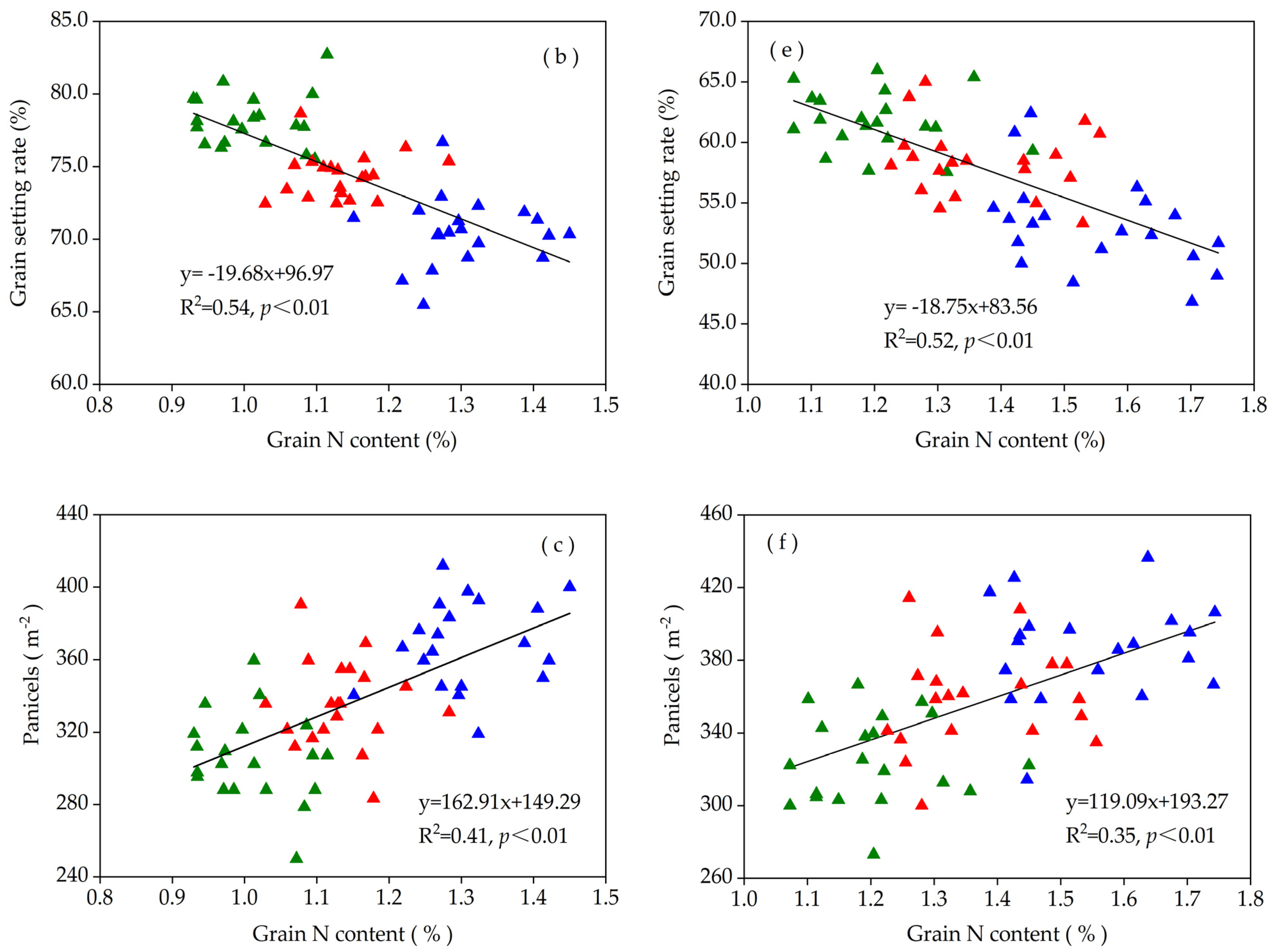Varietal Variances of Grain Nitrogen Content and Its Relations to Nitrogen Accumulation and Yield of High-Quality Rice under Different Nitrogen Rates
Abstract
1. Introduction
2. Materials and Methods
2.1. Site Description
2.2. Experimental Design
2.3. Sampling and Measurements
2.4. Statistical Analysis
3. Results
3.1. Grain N Content and Its Variance
3.2. Yield, Relationship of Grain N Content with Yield and Its Components in Field Experiments
3.3. Yield and Grain N Accumulation in Micro-Plot Experiment
4. Discussion
4.1. Variances of Grain N Content and Its Correlation with Yield and Yield Components in Rice
4.2. Grain N Accumulation and Utilization under Different N Application Rates
5. Conclusions
Author Contributions
Funding
Institutional Review Board Statement
Informed Consent Statement
Data Availability Statement
Conflicts of Interest
References
- Cheng, S.; Cao, L.; Zhuang, J.; Chen, S.; Zhan, X.; Fan, Y.; Zhu, D.; Min, S. Super hybrid rice breeding in China: Achievements and prospects. J. Integr. Plant Biol. 2007, 49, 805–810. [Google Scholar] [CrossRef]
- Wang, F.; Peng, S. Yield potential and nitrogen use efficiency of China’s super rice. J. Integr. Agric. 2017, 16, 1000–1008. [Google Scholar] [CrossRef]
- Cong, X.; Shi, F.; Ruan, X.; Luo, R.; Ma, Y.; Luo, Z. Effects of nitrogen fertilizer application rate on nitrogen use efficiency and grain yield and quality of different rice varieties. Chin. J. Appl. Ecol. 2017, 28, 1219–1226. [Google Scholar]
- Zhou, T.; Li, Z.; Li, E.; Wang, W.; Yuan, L.; Zhang, H.; Liu, L.; Wang, Z.; Gu, J.; Yang, J. Optimization of nitrogen fertilization improves rice quality by affecting the structure and physicochemical properties of starch at high yield levels. J. Integr. Agric. 2022, 21, 1576–1592. [Google Scholar]
- Peng, S.; Gurdev, S.K.; Parminder, V.; Tang, Q.; Zou, Y. Progress in ideotype breeding to increase rice yield potential. Field Crops Res. 2008, 108, 32–38. [Google Scholar] [CrossRef]
- Cui, Z.; Zhang, H.; Chen, X.; Zhang, C.; Ma, W.; Huang, C.; Zhang, W.; Mi, G.; Miao, Y.; Li, X. Pursuing sustainable productivity with millions of smallholder farmers. Nature 2018, 555, 363–366. [Google Scholar] [CrossRef]
- Tang, L.; Xu, Z.; Chen, W. Advances and prospects of super rice breeding in China. J. Integr. Agric. 2017, 16, 984–991. [Google Scholar] [CrossRef]
- Lin, H.; Wang, Z.E.Z.; Li, H.; Pang, Q. Analysis on characteristics of rice varieties registered in China in 2018. China Rice 2019, 25, 65–71. (In Chinese) [Google Scholar]
- Zhao, Z.; Dai, L.; Huang, J.; Pan, X.; You, A.; Zhao, Q.; Chen, G.; Zhou, Z.; Hu, W.; Ji, L. Status, problems and solution in rice industry development in the middle reaches of the Yangtze River. Chin. J. Rice Sci. 2019, 33, 553–564. (In Chinese) [Google Scholar]
- Cheng, B.; Jiang, Y.; Cao, C. Balance rice yield and eating quality by changing the traditional nitrogen management for sustainable production in China. J. Clean. Prod. 2021, 312, 127793. [Google Scholar] [CrossRef]
- Wei, H.; Meng, T.; Li, X.; Dai, Q.; Zhang, H.; Yin, X. Sink-source relationship during rice grain filling is associated with grain nitrogen concentration. Field Crops Res. 2018, 215, 23–38. [Google Scholar] [CrossRef]
- Kashiwagi, T. Effects of rice grain protein QTL, TGP12, on grain composition, yield components, and eating quality with different nitrogen applications. Field Crops Res. 2021, 263, 108051. [Google Scholar] [CrossRef]
- Zhang, J.; Tong, T.; Potcho, P.M.; Huang, S.; Ma, L.; Tang, X. Nitrogen effects on yield, quality and physiological characteristics of giant rice. Agronomy 2020, 10, 1816. [Google Scholar] [CrossRef]
- Che, S.; Zhao, B.; Li, Y.; Yuan, L.; Li, W.I.; Lin, Z.; Hu, S.; Shen, B. Review grain yield and nitrogen use efficiency in rice production regions in China. J. Integr. Agric. 2015, 14, 2456–2466. [Google Scholar] [CrossRef]
- Ju, C.; Zhu, Y.; Liu, T.; Sun, C. The effect of nitrogen reduction at different stages on grain yield and nitrogen use efficiency for nitrogen efficient rice varieties. Agronomy 2021, 11, 462. [Google Scholar] [CrossRef]
- Peng, J.; Feng, Y.; Wang, X.; Li, J.; Xu, G.; Somsana, P.; Luo, Q.; Han, Z.; Lu, W. Effects of nitrogen application rate on the photosynthetic pigment, leaf fluorescence characteristics, and yield of indica hybrid rice and their interrelations. Sci. Rep. 2021, 11, 7485. [Google Scholar] [CrossRef]
- Huang, S.; Zhao, C.; Zhu, Z.; Zhou, L.; Zheng, Q.; Wang, C. Characterization of eating quality and starch properties of two Wx alleles japonica rice cultivars under different nitrogen treatments. J. Integr. Agric. 2020, 19, 988–998. [Google Scholar] [CrossRef]
- Zhang, W.; Li, G.; Yang, Y.; Li, Q.; Zhang, J.; Liu, J.; Wang, S.; Tang, S.; Ding, Y. Effects of nitrogen application rate and ratio on lodging resistance of super rice with different genotypes. J. Integr. Agric. 2014, 13, 63–72. [Google Scholar] [CrossRef]
- Peng, S.; Buresh, R.J.; Huang, J.; Yang, J.; Zou, Y.; Zhong, X.; Wang, G.; Zhang, F. Strategies for overcoming low agronomic nitrogen use efficiency in irrigated rice systems in China. Field Crops Res. 2006, 96, 37–47. [Google Scholar] [CrossRef]
- Galloway, J.N.; Townsend, A.R.; Erisman, J.W.; Bekunda, M.; Cai, Z.; Freney, J.R.; Martinelli, L.A.; Seitzinger, S.P.; Sutton, M.A. Transformation of the nitrogen cycle: Recent trends, questions, and potential solutions. Science 2008, 320, 889–892. [Google Scholar] [CrossRef]
- Guo, J.; Liu, X.; Zhang, Y.; Shen, J.; Han, W.; Zhang, W.; Christie, P.; Goulding, K.; Vitousek, P.M.; Zhang, F. Significant acidification in major Chinese croplands. Science 2010, 327, 1008–1010. [Google Scholar] [CrossRef] [PubMed]
- Shi, L.; Zhang, X.; Sun, H.; Cao, X.; Liu, J.; Zhang, Z. Relationship of grain protein content with cooking and eating quality as affected by nitrogen fertilizer at late growth stage for different types of rice varieties. Chin. J. Rice Sci. 2019, 33, 541–552. (In Chinese) [Google Scholar]
- Haque, A.N.A.; Uddin, M.K.; Sulaiman, M.F.; Amin, A.M.; Hossain, M.; Solaiman, Z.M.; Aziz, A.A.; Mosharrof, M. Combined use of biochar with 15N labelled urea increases rice yield, N use efficiency and fertilizer N recovery under Water-saving irrigation. Sustainability 2022, 14, 7622. [Google Scholar] [CrossRef]
- Du, S.; Zhang, Z.; Chen, P.; Li, T.; Han, Y.; Song, J. Fate of each period fertilizer N in Mollisols under water and N management: A 15N tracer study. Agric. Water Manag. 2022, 272, 107872. [Google Scholar] [CrossRef]
- Lin, J.; Li, G.; Xue, L.; Zhang, W.; Xu, H.; Wang, S.; Yang, L.; Ding, Y. Subdivision of nitrogen use efficiency of rice based on 15N tracer. Acta Agron. Sin. 2014, 40, 1424–1434. (In Chinese) [Google Scholar] [CrossRef]
- Huang, M.; Cao, J.; Liu, Y.; Zhang, M.; Hu, L.; Xiao, Z.; Cao, F. Low-temperature stress during the flowering period alters the source–sink relationship and grain quality in field-grown late-season rice. J. Agron. Crop Sci. 2021, 207, 833–839. [Google Scholar] [CrossRef]
- Lan, Y.; Sui, X.; Wang, J.; Duan, Q.; Wu, C.; Ding, C.; Li, T. Effects of nitrogen application rate on protein components and yield of low-gluten rice. Agriculture 2021, 11, 302. [Google Scholar] [CrossRef]
- Jahan, A.; Islam, A.; Sarkar, M.I.U.; Iqbal, M.; Ahmed, M.N.; Islam, M.R. Nitrogen response of two high yielding rice varieties as influenced by nitrogen levels and growing seasons. Geol. Ecol. Landsc. 2022, 6, 24–31. [Google Scholar] [CrossRef]
- Liu, Q.; Xiu, W.; Chen, B.; Jie, G. Effects of low light on agronomic and physiological characteristics of rice including grain yield and quality. Rice Sci. 2014, 21, 243–251. [Google Scholar] [CrossRef]
- Xie, X.; Shan, S.; Wang, Y.; Cao, F.; Chen, J.; Huang, M.; Zou, Y. Dense planting with reducing nitrogen rate increased grain yield and nitrogen use efficiency in two hybrid rice varieties across two light conditions. Field Crops Res. 2019, 236, 24–32. [Google Scholar] [CrossRef]
- Zhang, H.; Hou, D.; Peng, X.; Shao, S.; Jing, W.; Gu, J.; Liu, L.; Wang, Z.; Liu, Y.; Yang, J. Optimizing integrative cultivation management improves grain quality while increasing yield and nitrogen use efficiency in rice. J. Integr. Agric. 2019, 18, 2716–2731. [Google Scholar] [CrossRef]
- Liang, H.; Gao, S.; Ma, J.; Zhang, T.; Wang, T.; Zhang, S.; Wu, Z. Effect of Nitrogen Application Rates on the Nitrogen Utilization, Yield and Quality of Rice. Food Nutr. Sci. 2021, 12, 13–27. [Google Scholar] [CrossRef]
- Xing, Y.; Mi, F.; Wang, X. Effects of different nitrogen fertilizer types and application rates on maize yield and nitrogen use efficiency in Loess Plateau of China. J. Soils Sediments 2022, 22, 1938–1958. [Google Scholar] [CrossRef]
- Li, L.; Tian, H.; Zhang, M.; Fan, P.; Umair, A.; Liu, H.; Duan, M.; Tang, X.; Wang, Z.; Zhang, Z.; et al. Deep placement of nitrogen fertilizer increases rice yield and nitrogen use efficiency with fewer greenhouse gas emissions in a mechanical direct-seeded cropping system. Crop J. 2021, 9, 1386–1396. [Google Scholar] [CrossRef]
- Zhou, C.; Huang, Y.; Jia, B.; Wang, Y.; Wang, Y.; Xu, Q.; Li, R.; Wang, S.; Dou, F. Effects of cultivar, nitrogen rate, and planting density on rice-grain quality. Agronomy 2018, 8, 246. [Google Scholar] [CrossRef]
- Swarbreck, S.M.; Wang, M.; Wang, Y.; Kindred, D.; Sylvester-Bradley, R.; Shi, W.; Bentley, A.R.; Griffiths, H. A roadmap for lowering crop nitrogen requirement. Trends Plant Sci. 2019, 24, 892–904. [Google Scholar] [CrossRef]
- Wang, J.; Fu, P.; Wang, F.; Fahad, S.; Mohapatra, P.K.; Chen, Y.; Zhang, C.; Peng, S.; Cui, K.; Nie, L.; et al. Optimizing nitrogen management to balance rice yield and environmental risk in the Yangtze River’s middle reaches. Environ. Sci. Pollut. Res. 2019, 26, 4901–4912. [Google Scholar] [CrossRef]
- Wang, D.; Xu, C.; Yan, J.; Zhang, X.; Chen, S.; Chauhan, B.S.; Zhang, X. 15N tracer-based analysis of genotypic differences in the uptake and partitioning of N applied at different growth stages in transplanted rice. Field Crops Res. 2017, 211, 27–36. [Google Scholar] [CrossRef]
- Chen, P.; Nie, T.; Chen, S.; Zhang, Z.; Qi, Z.; Liu, W. Recovery efficiency and loss of 15N-labelled urea in a rice-soil system under water saving irrigation in the Songnen Plain of Northeast China. Agric. Water Manag. 2019, 222, 139–153. [Google Scholar] [CrossRef]
- Lin, Z.; Yi, Z. Effect of nitrogen application rate on yield formation and nitrogen use efficiency of the high-quality late rice variety Shengtaiyou 018. Crop Res. 2021, 35, 293–296. (In Chinese) [Google Scholar]




| Number | Name | Type | Released Year | Number | Name | Type | Released Year |
|---|---|---|---|---|---|---|---|
| 1 | Y-liangyou 911 | Hybrid | 2018 | 11 | Longxiangyouhuazhan | Hybrid | 2016 |
| 2 | Yujing 91 | Inbred | 2015 | 12 | Xiangyaxiangzhen | Inbred | 2013 |
| 3 | Wanxiangyou 982 | Hybrid | 2019 | 13 | Yuzhenxiang | Inbred | 2009 |
| 4 | Meixiangzhan 2 | Inbred | 2006 | 14 | Taixiangyouyuesimiao | Hybrid | 2018 |
| 5 | Taiyou 553 | Hybrid | 2019 | 15 | Changyouhuazhan | Hybrid | 2018 |
| 6 | Taiyouhang 1573 | Hybrid | 2016 | 16 | Taifengyou208 | Hybrid | 2018 |
| 7 | Meitezhan | Inbred | 2019 | 17 | Yueyousimiao | Inbred | 2011 |
| 8 | Taoyouxiangzhan | Hybrid | 2015 | 18 | Wanxiangyouhuazhan | Hybrid | 2017 |
| 9 | Yexiangyoulisi | Hybrid | 2017 | 19 | Leiyou1068 | Hybrid | 2018 |
| 10 | Yexiangyoubasi | Hybrid | 2019 | 20 | Taiyou871 | Hybrid | 2016 |
| Varieties | Grain N Content in 2019 (%) | Grain N Content in 2020 (%) | CV (%) | ||||
|---|---|---|---|---|---|---|---|
| N105 | N165 | N225 | N105 | N165 | N225 | ||
| Y-liangyou 911 | 1.07 ab | 1.18 bcd | 1.33 bcd | 1.20 de | 1.28 efgh | 1.45 ghi | 10.36 |
| Taiyou 553 | 1.10 a | 1.18 bc | 1.42 a | 1.11 fgh | 1.23 h | 1.47 gh | 12.44 |
| Meixiangzhan 2 | 1.01 cd | 1.08 fghi | 1.28 de | 1.10 gh | 1.26 gh | 1.43 hi | 12.99 |
| Changyouhuazhan | 1.03 bc | 1.07 ghi | 1.30 de | 1.07 h | 1.26 gh | 1.42 hi | 13.17 |
| Longxiangyouhuazhan | 0.95 efg | 1.09 fghi | 1.27 de | 1.18 efg | 1.31 efg | 1.39 i | 13.43 |
| Yuzhenxiang | 1.11 a | 1.22 ab | 1.41 ab | 1.36 b | 1.53 ab | 1.62 cde | 13.59 |
| Taiyou 871 | 1.08 a | 1.16 bcde | 1.32 cd | 1.15 efgh | 1.33 ef | 1.56 ef | 13.69 |
| Taixiangyouyuesimiao | 0.93 fg | 1.11 defgh | 1.28 de | 1.12 fgh | 1.25 gh | 1.41 hi | 13.99 |
| Taoyouxiangzhan | 0.97 defg | 1.10 efghi | 1.30 d | 1.19 ef | 1.34 e | 1.44 hi | 14.06 |
| Yujing 91 | 1.09 a | 1.28 a | 1.39 abc | 1.22 cde | 1.56 a | 1.63 cd | 14.99 |
| Wanxiangyouhuazhan | 0.93 fg | 1.03 i | 1.22 e | 1.12 fgh | 1.27 fgh | 1.43 hi | 15.28 |
| Taiyouhang 1573 | 0.93 fg | 1.12 cdefgh | 1.25 de | 1.07 h | 1.30 efg | 1.45 ghi | 15.41 |
| Xiangyaxiangzhen | 1.02 cd | 1.17 bcd | 1.31 d | 1.28 bcd | 1.44 d | 1.64 bcd | 16.32 |
| Taifengyou 208 | 0.97 defg | 1.13 cdefgh | 1.27 de | 1.22 cde | 1.32 ef | 1.59 de | 16.53 |
| Yexiangyoubasi | 1.09 a | 1.14 cdefg | 1.33 bcd | 1.30 bc | 1.51 abc | 1.74 a | 18.17 |
| Wanxiangyou 982 | 0.99 cdef | 1.13 cdefgh | 1.25 de | 1.19 ef | 1.30 efg | 1.51 fg | 18.28 |
| Meitezhan | 1.01 cd | 1.13 cdefgh | 1.26 de | 1.45 a | 1.53 ab | 1.70 ab | 19.20 |
| Yexiangyoulisi | 1.00 cde | 1.15 cdef | 1.45 a | 1.20 de | 1.44 d | 1.70 ab | 19.31 |
| Yueyousimiao | 0.93 g | 1.17 bcde | 1.29 de | 1.22 cde | 1.49 bcd | 1.68 abc | 20.08 |
| Leiyou 1068 | 0.97 defg | 1.06 hi | 1.43 a | 1.31 b | 1.45 cd | 1.74 a | 21.26 |
| Mean | 1.01 C | 1.14 B | 1.32 A | 1.20 C | 1.37 B | 1.55 A | |
| Varieties | Grain Yield in 2019 (t ha−1) | Grain Yield in 2020 (t ha−1) | ||||
|---|---|---|---|---|---|---|
| N105 | N165 | N225 | N105 | N165 | N225 | |
| Y-liangyou 911 | 7.80 a | 8.78 a | 9.47 a | 7.45 ab | 8.24 a | 8.51 a |
| Taiyou 553 | 7.35 bcd | 8.26 bc | 8.17 de | 6.94 cde | 7.55 cde | 6.88 ef |
| Meixiangzhan 2 | 6.85 gh | 7.56 gh | 7.51 ij | 5.74 k | 6.27 j | 5.32 n |
| Changyouhuazhan | 7.88 a | 8.72 a | 9.32 a | 7.55 a | 8.26 a | 8.71 a |
| Longxiangyouhuazhan | 7.44 bc | 8.29 b | 8.52 bc | 7.09 c | 7.91 b | 7.11 de |
| Yuzhenxiang | 6.64 h | 7.31 i | 7.37 j | 6.06 hijk | 6.59 ij | 6.35 hij |
| Taiyou 871 | 7.46 bc | 8.23 bc | 8.56 b | 6.94 cde | 7.73 bcd | 7.27 cd |
| Taixiangyouyuesimiao | 7.44 bc | 8.20 bc | 8.35 bcd | 7.10 bc | 7.81 bcd | 7.54 c |
| Taoyouxiangzhan | 7.16 def | 7.72 fg | 7.88 fgh | 7.08 c | 7.95 ab | 8.14 b |
| Yujing 91 | 6.79 h | 7.49 hi | 7.61 hij | 5.90 jk | 6.32 j | 5.65 lm |
| Wanxiangyouhuazhan | 7.41 bc | 8.11 bcd | 7.82 gh | 6.70 def | 7.32 ef | 6.45 ghi |
| Taiyouhang 1573 | 7.56 b | 8.17 bc | 8.46 bc | 6.86 cde | 7.91 b | 7.32 cd |
| Xiangyaxiangzhen | 7.05 fg | 7.88 ef | 7.66 hi | 6.00 ijk | 6.95 gh | 6.10 jk |
| Taifengyou 208 | 7.32 bcde | 8.27 bc | 8.63 b | 6.99 cd | 7.84 bc | 7.23 d |
| Yexiangyoubasi | 7.15 def | 7.91 def | 7.95 efg | 6.13 hij | 6.66 hi | 5.96 k |
| Wanxiangyou 982 | 7.32 bcde | 8.08 cd | 7.65 hi | 6.84 cde | 7.51 de | 6.68 fg |
| Meitezhan | 7.10 ef | 7.80 ef | 7.43 ij | 6.60 efg | 6.66 hi | 5.47 mn |
| Yexiangyoulisi | 7.25 cdef | 7.95 de | 8.15 def | 6.33 ghi | 6.95 gh | 6.26 ij |
| Yueyousimiao | 7.27 cdef | 7.92 def | 7.88 fgh | 6.69 defg | 7.15 fg | 6.62 fgh |
| Leiyou 1068 | 7.48 bc | 8.18 bc | 8.27 cd | 6.41 fgh | 6.89 ghi | 5.88 kl |
| Mean | 7.29 B | 8.04 A | 8.13 A | 6.67 C | 7.32 A | 6.77 B |
| Treatment | Variety | Panicles m−2 | Spikelets Panicle−1 | Grain Setting Rate(%) | 1000-Grain Weight (g) | Yield (g m−2) | Biomass (g m−2) | Harvest Index (%) |
|---|---|---|---|---|---|---|---|---|
| N165 | Y-liangyou 911 | 342.36 d | 174.47 a | 86.25 a | 23.75 a | 1057.45 b | 2193.09 b | 54.57 a |
| Yexiangyoulisi | 369.78 c | 160.98 c | 85.36 b | 22.62 c | 993.95 c | 2090.13 c | 53.81 b | |
| N225 | Y-liangyou 911 | 407.82 b | 167.63 b | 83.06 c | 23.31 b | 1144.32 a | 2447.05 a | 51.72 c |
| Yexiangyoulisi | 437.90 a | 146.07 d | 81.59 d | 22.38 d | 1009.64 c | 2214.31 b | 50.63 d | |
| Analysis of Variance | Treatment | ** | ** | ** | ** | ** | ** | ** |
| Variety | ** | ** | ** | ** | ** | ** | ** | |
| Treatment × Variety | ns | ** | ns | ** | ** | ** | ns |
| 15N label | Treatment | Variety | N Content (%) | Total N Accumulation (g m−2) | 15N Labeled Fertilizer N Accumulation (g m−2) | Ratio of 15N Labeled Fertilizer N Accumulation to Total N Accumulation (%) |
|---|---|---|---|---|---|---|
| T1 | N165 | Y-liangyou 911 | 1.30 c | 13.84 c | 1.02 b | 7.36 c |
| Yexiangyoulisi | 1.32 c | 13.08 d | 0.89 c | 6.82 d | ||
| N225 | Y-liangyou 911 | 1.42 b | 16.42 a | 1.35 a | 8.23 b | |
| Yexiangyoulisi | 1.47 a | 14.77 b | 1.34 a | 9.11 a | ||
| T2 | N165 | Y-liangyou 911 | 1.29 d | 13.63 c | 0.79 c | 5.80 c |
| Yexiangyoulisi | 1.33 c | 13.22 c | 0.71 d | 5.38 d | ||
| N225 | Y-liangyou 911 | 1.41 b | 16.06 a | 1.26 a | 7.84 b | |
| Yexiangyoulisi | 1.46 a | 14.92 b | 1.30 a | 8.70 a | ||
| T3 | N165 | Y-liangyou 911 | 1.28 c | 13.49 c | 1.35 b | 10.02 d |
| Yexiangyoulisi | 1.31 c | 12.99 c | 1.35 b | 10.42 c | ||
| N225 | Y-liangyou 911 | 1.41 b | 16.35 a | 1.84 a | 11.22 b | |
| Yexiangyoulisi | 1.45 a | 14.63 b | 1.81 a | 12.36 a |
| 15N Label | Treatment | Variety | 15N Labeled Fertilizer N Recovery Rate (%) | N Harvest Index of 15N Labeled Fertilizer (%) |
|---|---|---|---|---|
| T1 | N165 | Y-liangyou 911 | 21.35 b | 57.84 a |
| Yexiangyoulisi | 19.26 c | 56.17 ab | ||
| N225 | Y-liangyou 911 | 22.25 a | 53.97 b | |
| Yexiangyoulisi | 21.10 b | 56.63 a | ||
| T2 | N165 | Y-liangyou 911 | 27.62 b | 57.86 ab |
| Yexiangyoulisi | 24.89 c | 57.73 ab | ||
| N225 | Y-liangyou 911 | 31.72 a | 55.11 b | |
| Yexiangyoulisi | 31.20 a | 59.71 a | ||
| T3 | N165 | Y-liangyou 911 | 67.60 c | 60.61 a |
| Yexiangyoulisi | 68.52 bc | 59.89 ab | ||
| N225 | Y-liangyou 911 | 70.60 ab | 57.76 bc | |
| Yexiangyoulisi | 70.97 a | 56.63 c |
Publisher’s Note: MDPI stays neutral with regard to jurisdictional claims in published maps and institutional affiliations. |
© 2022 by the authors. Licensee MDPI, Basel, Switzerland. This article is an open access article distributed under the terms and conditions of the Creative Commons Attribution (CC BY) license (https://creativecommons.org/licenses/by/4.0/).
Share and Cite
Wu, J.; Que, R.; Qi, W.; Duan, G.; Wu, J.; Zeng, Y.; Pan, X.; Xie, X. Varietal Variances of Grain Nitrogen Content and Its Relations to Nitrogen Accumulation and Yield of High-Quality Rice under Different Nitrogen Rates. Agronomy 2022, 12, 2719. https://doi.org/10.3390/agronomy12112719
Wu J, Que R, Qi W, Duan G, Wu J, Zeng Y, Pan X, Xie X. Varietal Variances of Grain Nitrogen Content and Its Relations to Nitrogen Accumulation and Yield of High-Quality Rice under Different Nitrogen Rates. Agronomy. 2022; 12(11):2719. https://doi.org/10.3390/agronomy12112719
Chicago/Turabian StyleWu, Jiale, Renwei Que, Wenle Qi, Gangqiang Duan, Jingjing Wu, Yongjun Zeng, Xiaohua Pan, and Xiaobing Xie. 2022. "Varietal Variances of Grain Nitrogen Content and Its Relations to Nitrogen Accumulation and Yield of High-Quality Rice under Different Nitrogen Rates" Agronomy 12, no. 11: 2719. https://doi.org/10.3390/agronomy12112719
APA StyleWu, J., Que, R., Qi, W., Duan, G., Wu, J., Zeng, Y., Pan, X., & Xie, X. (2022). Varietal Variances of Grain Nitrogen Content and Its Relations to Nitrogen Accumulation and Yield of High-Quality Rice under Different Nitrogen Rates. Agronomy, 12(11), 2719. https://doi.org/10.3390/agronomy12112719






